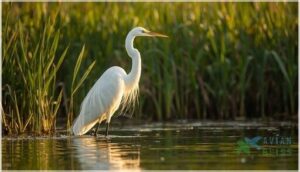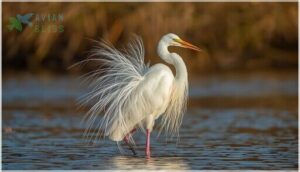This site is supported by our readers. We may earn a commission, at no cost to you, if you purchase through links.

You’ve seen them standing motionless in shallow water, tall and ghostly white against the reeds. The great egret’s skeletal elegance makes it one of the most recognizable wading birds across six continents, yet this widespread presence almost didn’t happen.
A century ago, plume hunters nearly drove the species to extinction, targeting their delicate breeding feathers for the fashion industry. That near-disaster sparked America’s first major conservation movement and reshaped how we protect wildlife today.
Now thriving in wetlands from coastal marshes to inland swamps, great egrets showcase impressive hunting skills with strike rates up to 70%, adapting their techniques across dramatically different environments. Understanding what makes these birds successful helps explain both their dramatic recovery and the new challenges they face from disappearing habitat.
Table Of Contents
- Key Takeaways
- Great Egret Appearance and Identification
- Habitat and Geographic Range
- Behavior and Daily Life
- Diet and Feeding Habits
- Conservation Status and Threats
- Frequently Asked Questions (FAQs)
- What is the difference between a great white heron and an egret?
- What states do Great Egrets live in?
- Is the Great Egret a heron?
- What is special about Great Egrets?
- How long do great egrets typically live?
- Can great egrets be kept as pets?
- Do great egrets migrate? If so, how far?
- Are there any predators that hunt great egrets?
- How do great egrets communicate with each other?
- What predators threaten great egret eggs and chicks?
- Conclusion
Key Takeaways
- Great egrets nearly went extinct in the late 1800s due to plume hunting for fashion, but legal protections like the Lacey Act and efforts by the Audubon Society sparked their dramatic recovery and shaped modern wildlife conservation.
- These adaptable hunters achieve strike rates up to 70% by using varied techniques like stand-and-wait, slow walking, and foot-stirring across diverse wetlands from coastal marshes to urban ponds.
- Great egrets can be identified by their all-white plumage, yellow bill, black legs, and skeletal elegance, with breeding adults displaying showy plumes and dramatic color shifts in their bills and lores.
- Despite their successful comeback, great egrets still face serious threats from wetland degradation and climate change, with projected habitat losses of 27% forcing populations to concentrate in remaining coastal refuges.
Great Egret Appearance and Identification
Spotting a Great Egret in the wild is all about the details. The next sections will walk you through what to look for and how to tell this bird apart from others.
Here’s what you need to know when you’re out in the field.
Size and Physical Characteristics
Think of the great egret as a study in balance and grace. Its body stretches 80–104 cm with a wingspan from 131–170 cm, creating a slim profile that stands out against wetlands. The Great Egret’s conservation status is Least Concern.
Here’s what sets it apart:
- Elongated neck and body proportions
- Slender, upright stance
- Noticeable skeletal structure
- Distinctive morphometric data
- Regional size variation
Distinctive Features and Color Pattern
You’ll spot a great egret by its all-white plumage coloration paired with a yellow bill and black legs—a key trio for great egret identification. During breeding, the bill color shifts from yellow to red or black, depending on the subspecies, while the legs may show a pink or purplish wash. Watch for the gape line extending behind the eye, completing the color pattern analysis.
These birds are common in North American wetlands.
Comparison to Similar Species
It’s easy to mistake a Great Egret for a Snowy Egret by size alone, but Snowy Egrets run smaller and show bright yellow feet. Compare the Great Blue Heron’s white morph—notice the heavier bill and pale legs versus the egret’s black.
Look closer: Intermediate Egrets, juvenile herons, and even citizen science misidentifications show Wading bird identification is rarely simple.
Breeding Adult Characteristics
Breeding adult Great Egrets catch your eye with bold changes. Their all-white bodies flash long, showy plumes above the tail, while bill coloration shifts from yellow to red-black, and lores glow green. Black legs can turn pink or red. These cues—alongside a slightly larger male size—signal:
- Plumage Changes
- Bill Coloration
- Leg Coloration
- Seasonal Timing
- Sexual Dimorphism
Subspecies and Regional Variations
Across their nearly global range, Great Egrets split into four subspecies with subtle differences. If you look closely, you’ll notice Morphological Differences, like body size, and Bare-Part Coloration, such as legs or bill color, that shift from Africa to Australia or South Asia.
Recent studies highlight Genetic Differentiation, too, informing ongoing Taxonomic Treatment and tracking shifting Range Dynamics over time.
Habitat and Geographic Range
Where you find Great Egrets often comes down to the shape of their favorite habitats and how well they adapt. Their range is wide, stretching across continents and different kinds of wetlands.
Let’s take a closer look at the places they call home and how they get around.
Preferred Wetland Ecosystems
Imagine a bird weaving through a mosaic of wetland habitats—Great Egrets thrive where water depth is just right. You’ll find them in coastal marshes, freshwater swamps, seagrass beds, and even artificial wetlands.
These habitats offer ideal conditions along shorelines, where Great Egret behavior focuses on foraging and nesting, shaping both their daily life and survival.
Global Distribution and Range
Stretching across nearly all continents except Antarctica, the Great Egret shows impressive bird migration and range. You’ll spot them from East Asia’s wetlands to the river deltas of New South Wales. Their subspecies ranges illustrate true species distribution, with range expansion still unfolding.
Here’s how their global footprint takes shape:
- Continental presence
- Breeding range
- Wintering distribution
- Subspecies ranges
- Geographic distribution of egrets
Migration and Seasonal Movements
Ever wondered how Great Egrets pick up and move with the changing seasons? Their migration patterns can be unpredictable—some stay put, while others travel thousands of kilometers between wetlands.
Seasonal timing and climate influences shape these journeys. Juvenile dispersal adds to the mix, weaving a tapestry of bird migration that keeps their species distribution flexible across shifting wintering grounds.
Adaptability to Diverse Environments
Think of the Great Egret as an expert at making do with change—its habitat plasticity shows everywhere, from brackish estuaries to city ponds.
These birds blend foraging innovation, salinity tolerance, and urban adaptation, letting them thrive despite climate change.
Thanks to broad diet flexibility, you’ll spot them weaving between natural wetlands and human-made landscapes—always adjusting, never standing still.
Behavior and Daily Life
Curious about how Great Egrets spend their days? Here’s what you’ll want to know about their daily habits and social rhythms.
Let’s look at the different ways these birds interact with their world.
Foraging and Hunting Techniques
When you watch a Great Egret, notice its patient slow walking or sudden stillness—both key locomotion modes shaped by habitat adjustments and energetic influences.
Great Egrets strike rapidly at fish or insects, balancing prey size against strike success. This feeding behavior lets them thrive in changing wetlands, making the Great Egret diet flexible across different environments and conditions.
Social and Flocking Behavior
Great Egrets aren’t lone hunters all the time—you’ll find them gathering in nesting colonies that can house hundreds of pairs alongside herons and cormorants. Territorial aggression flares at nest sites, with bill jabs and loud calls defending space.
Outside breeding season, communal roosting brings mixed-species interactions at dusk. Seasonal dispersal sends young egrets up to 257 km from their birthplace, reshaping colony formation across wetlands.
Key social patterns include:
- Breeding colonies with aggressive nest defense
- Communal roosting outside nesting periods
- Mixed-species feeding behavior and flocking
- Long-distance juvenile dispersal after fledging
Courtship Displays and Vocalizations
When breeding adults claim nest platforms, males launch into display flight rates averaging 4–6 circuits per hour to attract mates. You’ll witness upright poses with necks stretched skyward at 45-degree angles, plumes erected dramatically.
The greeting ceremony features synchronized neck stretching and two-syllable calls lasting 10–20 seconds. Agonistic displays—forward postures, bill duels—defend territory.
Their vocal repertoire includes harsh “kraak” distress calls and low “frawnk” advertising sounds.
Interactions With Other Bird Species
Beyond courtship, you’ll find these egrets rarely forage alone. In Florida wetlands, over 70% of their feeding happens alongside White Ibises and Great Blue Herons, creating vibrant mixed-species assemblages.
Key interspecific patterns:
- Foraging assemblages – Egrets join ibises in shared wetlands yet exploit wider water depths
- Interspecific competition – Spatial niche partitioning reduces direct conflicts over prey
- Colony nesting – Multi-species colonies concentrate within 400-meter zones
- Shared contexts – Common predators and hydrologic conditions shape guild functional roles
Diet and Feeding Habits
Great Egrets are patient hunters with a menu that’s mostly fish, though they’re not picky eaters when other prey shows up.
How they hunt depends on where they’re wading and what season it is. You’ll find they’ve developed some clever techniques to catch their meals in different wetland habitats.
Primary Food Sources
If you’re watching a great egret hunt, you’ll see fish dominance in action—fish make up the bulk of its diet across nearly all habitats. But amphibian importance shouldn’t be overlooked: frogs and salamanders are key prey in marshes.
Crustacean consumption rises in coastal waters, while aquatic insects and terrestrial prey like grasshoppers round out this opportunistic hunter’s menu.
Hunting Methods and Adaptations
When you watch a great egret hunt, you’ll notice its strike efficiency is impressive—50 to 70% of strikes capture prey in good conditions. You’ll see varied hunting behaviors unfold:
- Stand-and-wait postures in shallow water
- Slow-walking locomotion patterns between strikes
- Foot-stirring to flush hidden fish and aquatic insects
- Flush-pursuit tactics using branches or vegetation
- Habitat choices favoring human environments like shellfish farms
Great egret habitat quality and flight characteristics help these adaptable hunters exploit diverse wetlands.
Seasonal Variations in Diet
Throughout the year, you’ll see great egret feeding behavior shift with prey availability. During breeding season, fish dominate the diet at over 70% of biomass in some colonies.
Spring amphibians like frogs and tadpoles increase after May in wetlands. By late summer, mammals such as voles become key prey when aquatic sources decline.
Climate variability and habitat linkages drive these seasonal shifts in great egret diet and behavior.
Feeding in Different Habitats
Across wetland foraging habitats, you’ll notice great egrets adjust feeding behavior based on local conditions. Their versatility lets them exploit fish, invertebrates, and amphibians in diverse settings—from marshes to modified urban habitats.
Here’s how great egrets adapt to specific environments:
- Freshwater marshes: Shallow depths below 0.5 m support efficient hunting with lower energy costs in vegetated areas.
- Coastal eelgrass beds: Preferred over aquaculture zones despite higher movement demands.
- Rice fields: Agricultural feeding on loaches and tadpoles peaks during flooding cycles.
- Urban ponds and canals: Artificial wetlands concentrate prey but increase contaminant exposure risk.
- Habitat modification trade-offs: Drainage and pollution degrade natural sites while creating new feeding opportunities.
Conservation Status and Threats
The Great Egret’s story is one of the most dramatic comebacks in conservation history. After facing near-extinction in the late 1800s, these elegant waders have bounced back remarkably well, though new challenges continue to emerge.
Let’s look at how their populations have changed over time and what threats they face today.
Historical Decline and Recovery
Did you know the fight to save the Great Egret reshaped bird conservation? Plume hunting for fashion nearly led to extinction, but the Audubon Society and the Lacey Act threw lifelines. Conservation efforts for birds gained traction, setting a powerful historical context for today’s recovery.
The fight to save the Great Egret from plume hunting reshaped bird conservation through the Audubon Society and the Lacey Act
| Factor | Before Protection | After Legal Action |
|---|---|---|
| Plume Hunting | Rampant | Outlawed |
| Egret Population | Plummeting | Rebounding |
| Audubon Society Role | Founded | Advocacy Grows |
| Lacey Act Impact | Pending | Enforced |
| Habitat Degradation | Increasing | Ongoing Threat |
Current Population Trends
What’s behind the Great Egret’s comeback? You’ll find conservation success stories in many regions, but the full picture is patchy. Here’s what stands out:
- Regional population changes show strong gains in North America and Europe.
- Monitoring data gaps persist globally, especially outside breeding season.
- Christmas Bird Count numbers keep climbing.
- Long-term projections hinge on climate change impacts and ongoing conservation efforts for birds.
Habitat Loss and Climate Change
Wetland degradation hits Great Egret populations hard. Dramatic examples include Florida’s Everglades, which lost 90% of breeding pairs, and eastern Australia’s coastal numbers, which plummeted 80% between 1988 and 1999.
Water alterations from dams and drainage destroy feeding areas, while salinization effects kill nesting trees.
Climate change threats project a 27% habitat contraction, forcing population responses as birds concentrate in remaining estuaries and coastal refuges.
Frequently Asked Questions (FAQs)
What is the difference between a great white heron and an egret?
It’s oddly easy to confuse a great white heron and an egret—until you spot the Morphological Differences: the heron’s bulkier frame, yellow legs, and stouter bill.
That ongoing Taxonomic Debate and Habitat Overlap muddy bird identification.
What states do Great Egrets live in?
You’ll find these North American birds year-round across the Sun Belt—from Florida and Texas to California—plus breeding colonies along the Atlantic and Gulf coasts, Great Lakes, and even scattered summer sites at the northern edge of their range.
Is the Great Egret a heron?
It’s a bit of a scientific riddle: taxonomic classification places this long-legged wading bird squarely with the herons.
Nomenclature usage blurs the line, but by every morphological measure, the so-called “egret” is truly a heron.
What is special about Great Egrets?
You’ll find their elegant plumage stunning—all-white feathers with striking black legs.
Their adaptive behavior and conservation success story make them cultural icons and valuable wetland indicators, reflecting healthy ecosystems wherever they thrive.
How long do great egrets typically live?
You’ll find great egrets live about 15 years in wild conditions, though captive longevity reaches 22 years.
Survival rates improve after maturity age (2–3 years), with environmental influences and conservation status affecting their bird behavior and habitat success.
Can great egrets be kept as pets?
No, you can’t keep great egrets as pets. Federal law protects them under the Migratory Bird Treaty Act, making possession illegal.
Captivity challenges their wild nature, and ethical concerns prioritize conservation over private ownership.
Do great egrets migrate? If so, how far?
Yes, Great Egrets migrate, with distance variations depending on breeding range and continental differences. Partial migration occurs—some populations stay put while others travel 800–1,000 km between seasonal areas, with juvenile migration often covering greater distances.
Are there any predators that hunt great egrets?
While aerial surveillance drones rarely threaten adult egrets thanks to bird conservation laws, nest predator types like raccoons devastate colonies.
Alligator protection role helps, though avian egret predators and intra-brood violence cause losses too.
How do great egrets communicate with each other?
Great Egrets use visual displays, acoustic signals, and tactile communication during feeding. These sensory modalities coordinate territorial signaling, courtship, and nesting behavior throughout breeding seasons.
What predators threaten great egret eggs and chicks?
Like a thief in the night, raccoons pose the greatest threat to nesting colonies, snatching eggs and chicks.
Crows, vultures, hawks, and snakes also exploit nesting vulnerability, driving predation rates to 17% in monitored sites.
Conclusion
You might think one species’ comeback story doesn’t matter much in today’s rapidly changing world, but the great egret proves otherwise. Its dramatic recovery from near-extinction shows that dedicated conservation efforts actually work when we commit to them.
These elegant hunters now thrive across wetlands worldwide, reminding us that protecting critical habitats benefits entire ecosystems. Their success isn’t just about saving one bird—it’s about preserving the wild spaces we all need.












